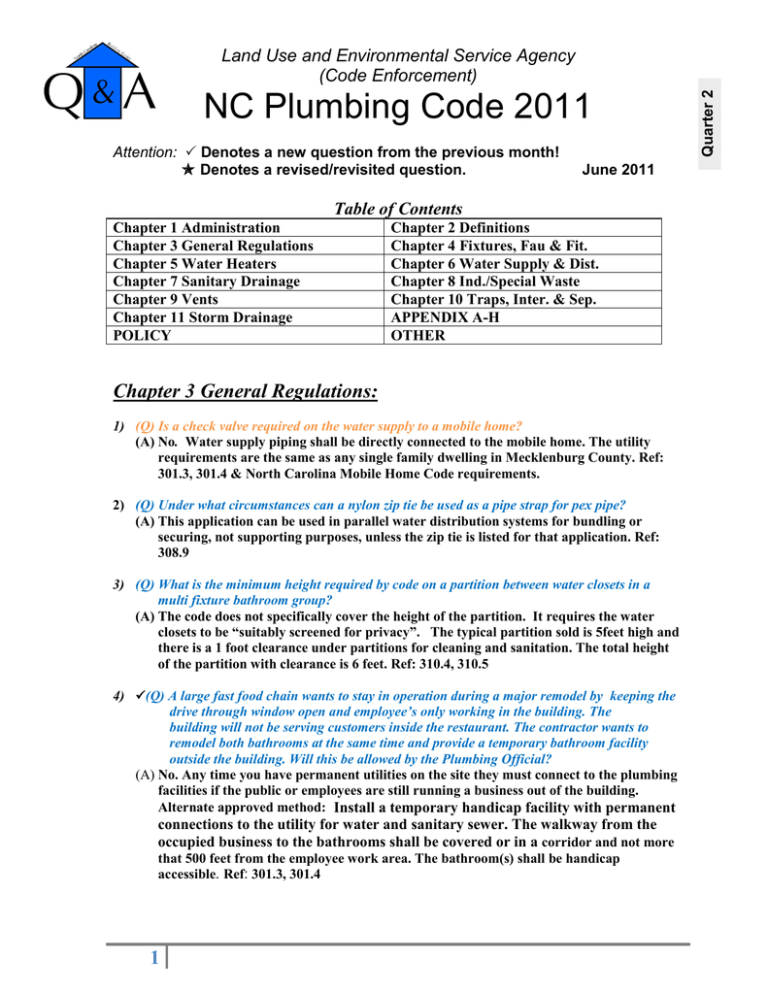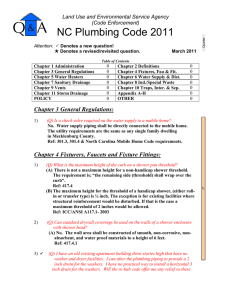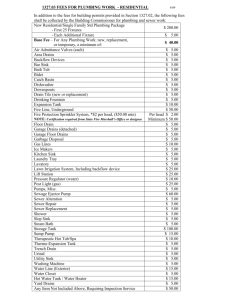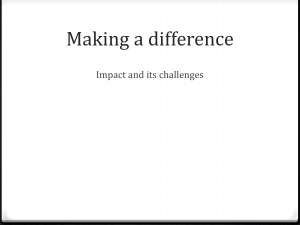NC Plumbing Code 2011 Land Use and Environmental Service Agency (Code Enforcement)
advertisement

NC Plumbing Code 2011 Attention: Denotes a new question from the previous month! Denotes a revised/revisited question. June 2011 Table of Contents Chapter 1 Administration Chapter 3 General Regulations Chapter 5 Water Heaters Chapter 7 Sanitary Drainage Chapter 9 Vents Chapter 11 Storm Drainage POLICY Chapter 2 Definitions Chapter 4 Fixtures, Fau & Fit. Chapter 6 Water Supply & Dist. Chapter 8 Ind./Special Waste Chapter 10 Traps, Inter. & Sep. APPENDIX A-H OTHER Chapter 3 General Regulations: 1) (Q) Is a check valve required on the water supply to a mobile home? (A) No. Water supply piping shall be directly connected to the mobile home. The utility requirements are the same as any single family dwelling in Mecklenburg County. Ref: 301.3, 301.4 & North Carolina Mobile Home Code requirements. 2) (Q) Under what circumstances can a nylon zip tie be used as a pipe strap for pex pipe? (A) This application can be used in parallel water distribution systems for bundling or securing, not supporting purposes, unless the zip tie is listed for that application. Ref: 308.9 3) (Q) What is the minimum height required by code on a partition between water closets in a multi fixture bathroom group? (A) The code does not specifically cover the height of the partition. It requires the water closets to be “suitably screened for privacy”. The typical partition sold is 5feet high and there is a 1 foot clearance under partitions for cleaning and sanitation. The total height of the partition with clearance is 6 feet. Ref: 310.4, 310.5 4) (Q) A large fast food chain wants to stay in operation during a major remodel by keeping the drive through window open and employee’s only working in the building. The building will not be serving customers inside the restaurant. The contractor wants to remodel both bathrooms at the same time and provide a temporary bathroom facility outside the building. Will this be allowed by the Plumbing Official? (A) No. Any time you have permanent utilities on the site they must connect to the plumbing facilities if the public or employees are still running a business out of the building. Alternate approved method: Install a temporary handicap facility with permanent connections to the utility for water and sanitary sewer. The walkway from the occupied business to the bathrooms shall be covered or in a corridor and not more that 500 feet from the employee work area. The bathroom(s) shall be handicap accessible. Ref: 301.3, 301.4 1 Quarter 2 Land Use and Environmental Service Agency (Code Enforcement) NC Plumbing Code 2011 Attention: Denotes a new question from the previous month! Denotes a revised/revisited question. June 2011 5) (Q) Is it required to insulate thermal expansion tanks that are installed in residential garages? After all, there is very little if any water that would occupy space in the tank. Should any freezing occur, there would be ample room for any expansion within the tank. (A) The ruling from this department on insulating appliances in a garage has been; if the water piping must be insulated, then the expansion tank does as well. NCDOI has concurred with this interpretation and they state “if exposed inside an unheated residential garage, it must be insulated” Ref: 305.6 Chapter 4 Fixtures, Faucets and Fixture Fittings: 1) (Q) What is the maximum height of the curb on a shower pan threshold? (A) There is not a maximum height for a non-handicap shower threshold. The requirement is; “the remaining side (threshold) shall wrap over the curb”. Ref: 417.4The maximum height for the threshold of a handicap shower, (either roll-in or transfer type) is ½ inch. The exception is for existing facilities where structural reinforcement would be disturbed. If that is the case a maximum threshold of 2 inches would be allowed. Ref: ICC/ANSI A117.1- 2003 2) (Q) Can standard drywall coverings be used on the walls of a shower enclosure with shower head? (A) No. The wall area shall be constructed of smooth, non-corrosive, non-absorbent, and water proof materials to a height of 6 feet. Ref: 417.4.1 3) (Q) I have an old existing apartment building three stories high that have no washer and dryer facilities. I can alter the plumbing piping to provide a 2 inch drain for the washers. I have no practical way to install a horizontal 3inch drain for the washers. Will the re-hab code offer me any relief so these washers may be installed? (A) No. The Re-hab code offers the designer no relief from the horizontal 3 Inch drain requirement, however, the plumbing official may look at the existing DWV system to determine the feasibility of accommodating the washers before making a final determination. Ref: 406.3 4) (Q) Is a drain required for an outside shower used on a pool deck that hasonly a cold water connection? (A) No. The shower is not used for bathing and has no hot waterconnection. The water could be considered clear water waste under normal circumstances and can drain into the same system that is used for the pool deck drainage. Similar in some respects to Emergency Showers and Eyewash Stations. Ref: 411 5) Q) Are bottle trap installations allowed by the NC Plumbing Code? (A) Since they are not expressly prohibited by ICC we would have to approve them as long as they meet the standards listed under NC IPC 421.1.2 and comply with ASME A112.18.2. also, ref: 1002.3 #6 2 Quarter 2 Land Use and Environmental Service Agency (Code Enforcement) NC Plumbing Code 2011 Attention: Denotes a new question from the previous month! Denotes a revised/revisited question. June 2011 6) (Q) An engineer submits a plan with a system of trench drains in a factory that drain various grease producing cooking equipment to a grease interceptor located outside the building. The engineer wants to pour concrete forms and install stainless steel trench drain inserts in the concrete. The project is turned down by the plan examiner. Neither the plans nor specifications show how the project meets 412.1 construction requirements (ASME A112.6.3.). What information does the plan reviewer need to approve the review? (A) The Engineer suggested supplying a letter showing how the installation met the trench drain provision ASME A112.6.3. The CA agreed to review the engineers sealed letter. If the letter was disapproved by the CA the engineer would be required to provide trench drains that meet the code or have the trench drains field verified by a third party testing agency to meet the ASTM standard. Ref: 412.1. 7) (Q) My church has ball fields and they would like to build toilets facilities in lieu of the portable units they have now. Because they are not required by code do we have to meet a certain number of toilets? (A) The following code interpretation was put out by the department in 1993 with the assistance of the parks department and should be used as a guide to determine the fixture count for your church ball field. Ref: Table 403.1, Park Fixture Requirements. Revised April 2009. The information on calculating the minimum facilities is in the chapter 4 interpretations reference guide on our web site. Chapter 5 Water Heaters: 1) (Q) May a plastic safety pan be used for a gas fired instantaneous W/H? (A) Yes, provided that the water heaters minimum distance from combustible material is maintained. Ref: Manufacturers Instructions 2) (Q) What is the minimum size of a water heater pan drain per the current North Carolina Plumbing Code? (A) The plumbing code minimum in 504.7.1 requires a ¾ inch drain minimumThis is incorrect and is a misprint in the code. The correct minimum size is 1 Inch. See DOI letter From Henry Webster Chief Plumbing Engineer for the State Department of Insurance Office of the State Fire Marshall. 3) (Q) What is the maximum temperature setting for a tankless water heater allowed for a residential use only? What if temperature exceeds 140 degrees can the water heater still be installed? (A) 501.6 Maximum temperature is 140 degrees. 501.8 Where temperatures exceed 140 degrees a mixing valve shall be installed. 3 Quarter 2 Land Use and Environmental Service Agency (Code Enforcement) NC Plumbing Code 2011 Attention: Denotes a new question from the previous month! Denotes a revised/revisited question. June 2011 4) (Q) A plumbing contractor “converted” a water heater from a 12 kW to an 18kW. The water heater is located in the ceiling. It will be difficult for the inspector to observe the data plate of the water heater. The new data plate reflecting the 18KW change has been added to reflect the new heating capacity. The water heater now has dual (two) data plates. Is there a problem with this installation change? (A) Yes. Not allowed. The addition of a new data plate to the appliance negates the factory listing/labeling of the appliance. The labels should be installed at the factory. From our limited knowledge of this situation it sounds like a data plate has been taken from one heater and added to another. Ref: Labeled by the Manufacturer, see def. 501.9 Chapter 6 Water Supply & Distribution: 1) (Q) What is the maximum distance a fixture supply pipe may be from the fixture it serves? (A) Section 604.5 states 72”. 2) (Q) When are water hammer arrestors required? (A) The flow velocity of the water distribution system shall be controlled to reduce the possibility of water hammer. A water-hammer arrestor shall be installed where quickclosing valves (clothes washers and dishwashers) and metallic piping is used. The waterhammer arrestor shall not be required on any valves where plastic piping is used for water distribution. Water-hammer arrestors shall be installed in accordance with the manufacturer’s specifications. Water-hammer arrestors shall conform to ASSE 1010. Ref: 604.9 3) (Q) Does the Code require a water distribution system to be sanitized? (A) (No) 602.3.4 purged and disinfected, 610.1 purged of deleterious matter. 4) (Q) Is an expansion device required on a tankless water heater? (A) No. An expansion device is required only if there is a tank type waterheater installed in the residence. An expansion device is not required if hot water distribution is from a tankless water heater. Ref: 607.3 5) (Q) The Plumbing Code defines the "Water Supply System" and gives the point where the Water service pipe terminates and becomes the water distribution pipe. When the water is supplied by a well and not a meter what is the starting point of the service pipe inspection? (A) The plumbing inspections begin at the valve at the outlet of the pressure tank. Ref: 602.3.5, 602.3.5.1 4 Quarter 2 Land Use and Environmental Service Agency (Code Enforcement) NC Plumbing Code 2011 Attention: Denotes a new question from the previous month! Denotes a revised/revisited question. June 2011 6) (Q) When and where are pressure-reducing valves required by code, and upon what circumstances should the Inspectors be requiring them to be installed? (A) When the incoming water pressure exceeds 80 PSI, and on the cold water line no further downstream than the beginning of the water distribution system. Ref: 604.8 7) (Q) Past policies have required a expansion device installed on a closed water distribution system where there is a tank style water heater and/or backflow prevention- is this still the case? (A) Yes Ref: 604.8.1, 504.4.1 8) Q) How should expansion tanks be supported? (A) Per the tank manufacturers installation instructions. Ref: 607.3.2 9) (Q) Does the code allow a yard hydrant with a stop and waste that is fed from underground, potable water, yard irrigation loop? The irrigation system is for a garden and not close to any structure (A) No. The code does not allow a stop and waste on a potable water system. Any underground opening represents a possibility of contamination through back siphon age into the potable water system. Alternate approved method. A stop-and–waste may be installed in the situation noted above if a reduced pressure backflow preventer on the potable irrigation loop is installed and the piping is identified from the RP to the yard hydrant as non-potable water. Non -potable piping must be painted yellow with black lettering stating “NON POTABLE WATER”. Ref: 608.7, 608.8.2 Chapter 7 Sanitary Drainage: (1) (Q). Can a force main tie into gravity drain line? If yes can a Y connection be used for this purpose? What other requirements apply to meet code minimums? (A) Yes. Must be 10 feet from the base of any soil stack, waste stack, or fixture drain or the connection to a septic tank. Where the connection is to a horizontal drain pipe the ejector shall be made on top of the drain pipe through a wye fitting at an angle of 45 deg. Ref: 712.3.5 2) (Q) A plumbing contractor wants to use saddle valves to tap a live 6 inch main. The approval is based on an engineer approved letter of approval for use of the valve as an alternate method. Is this allowed? (A) No. Saddle valves are clearly prohibited by the code. Ref: 707.1 #6 3) (Q) Is the flexible drain line piping approved for under sink waste piping? (A) No. Flexible drain piping, sold at most of the big box stores, is not approved by the NC Plumbing Code. The fittings shall not have ledges, shoulders or reductions capable of retarding or obstructing flow in the piping. Threaded drainage pipe fittings shall be of the recessed drainage type. Ref: 706.2 5 Quarter 2 Land Use and Environmental Service Agency (Code Enforcement) NC Plumbing Code 2011 Attention: Denotes a new question from the previous month! Denotes a revised/revisited question. June 2011 Chapter 8 Indirect/Special Waste: 1) (Q) What is a sacristy and what special allowances apply? (A) It is one use where the drain is allowed to discharge directly into a drywell outside of the structure. Ref: 803.4 2) (Q) Can the tail piece of a lavatory or sink be used as a direct connection for the drainage from an ice maker or medical equipment? (A) No. An air gap shall be provided and the waste shall discharge into an approved receptor to protect against backflow. Ref: Section 801.2, 802.1, and 802.1.6 3) (Q) Do all acid waste neutralization tanks require a monitoring device with alarm? (A) Yes. We require monitoring and alarms on all neutralization tanks installed in Mecklenburg County. Ref: Code Interpretation Letter & 702.5/803.2,803.5. 4) (Q) Can the discharge from a three compartment sink in a commercial Restaurant be pumped to an indirect waste receptor in a remote location? (A) Yes. The three compartment sink shall discharge through a flow control fitting and a point of use grease interceptor before terminating in the lift station. The lift station pumped discharge shall have a check valve and terminate over an indirect waste receptor which must be visible from the three compartment sink location. Ref: 802.1.1, 802.2.1 5) (Q) Is a condensate pump that is not listed for installation in a plenum allowed in a plenum if it has all non –combustible parts? (A) Yes. (307.2.1, 307.2.2 Mech. Code) The plumbing official may allow the use of this pump as an equivalency to a listed pump under the conditions stated above. Ref: 801.1 Chapter 10 Traps, Interceptors & Seperators: 1) (Q) What is required for laundry drain protection for lint, buttons or strings? (A) Laundries other than a single family residence, shall be equipped with a manufactured device (not field fabricated) that will limit lint, buttons or string larger than ½” from entering the drainage system. Ref: 1003.6 2) (Q) Is a separate draw off storage tank allowed to be installed as part of an oil/water separator installation? (A) Yes. When circumstances exist on a site that would not permit the full storage tank capacity calculated for an integral storage oil/water separator to be installed, an integral separator sized to meet the minimum capacity of the code may be installed with an additional draw off tank to store the remaining capacity calculated for the separator. All other requirements for oil/water separators installed in Mecklenburg County shall remain the same. Ref: 1003.1, 1003.2, 1003.4, & 1003.4.2 6 Quarter 2 Land Use and Environmental Service Agency (Code Enforcement) NC Plumbing Code 2011 Attention: Denotes a new question from the previous month! Denotes a revised/revisited question. 3) June 2011 (Q) Grease interceptors that are required by the plumbing code and by Charlotte Mecklenburg Utility Department should be designed to meet both standards. The utility company would like Mecklenburg County to alter its policy statement. Is there any reason we should not honor that request? (A) No. Unless the change is a violation of current code we can honor their request. They would like us to add the access provision to our requirements. This standard provision would require access to each chamber separately of a grease interceptor. Out policy will be revised to reflect this change. Ref: 1003.3 4) (Q) The plumbing plans examiner has turned down a plan requiring a system of floor drains or trench drains in a repair garage that will have to discharge through an oil/water separator. The owner calls the CA to find out if he may use dry clean up and environmental disposal of waste just like the garage next door to his has for years? (A) If the owner does not have floor drains or trench drains and uses dry clean up and proper environmental disposal methods per our on line OWS interpretation, I see no reason to require the OWS. I would always advise checking the plans to get the overall picture of the project. We may not be getting the whole picture. If there are existing floors or trench drains in the original building they are adding on to then the new floor and trench drains should be added to the original drain installation and the OWS sized to accommodate all the waste from the garage floor. We need to get a letter from the owner about the pick up and disposal of the dry clean up material Ref: Oil Water Separator Policy letter on our web site. Exception to 1003.4 Chapter 11 Storm Drainage: 1) (Q) How do vertical walls affect roof drain calculations? (A) In sizing roof drains and storm drainage piping, one-half of the area of any vertical wall that diverts rainwater to the roof shall be added to the projected roof area for inclusion in calculating the required size of vertical conductors, leaders and horizontal storm drainage piping. Ref: 1106.4 2) (Q) I am attaching a handmade metal box I designed to a 4 inch overflow roof drain that terminates on the side wall of an apartment building. I am installing a screen in the box to restrict the flow so the water will not be pouring down the side of the building and staining the brick finish. Does this installation meet the Code? (A) No. The size of the drainage pipe is reduced in the direction of flow. The fitting is not approved and retards the direction of flow. The fitting has shoulders and/or reductions that retard flow. Strainers are allowed on roof surfaces only for overflow drains this is a side wall mounted fitting. Ref: 1101.5, 1101.6, 1102.7, 1105.1, 1107.2 7 Quarter 2 Land Use and Environmental Service Agency (Code Enforcement) NC Plumbing Code 2011 Attention: Denotes a new question from the previous month! Denotes a revised/revisited question. June 2011 3) (Q) Is it still applicable to use the 3.2” and 6.6” rainfall amounts for primary and secondary roof drain quantities? These values were in the table approved by Phil Edwards for rainfall as long as we noted on the plans that we used those totals? It has been about 8-12 months since I last checked. (A) Yes. You can still use either the NC Plumbing Code calculations or CMUD data. It is the designers’ choice as long as the code tables do not contain a lesser value than local weather conditions. The rainfall amounts in your email are from CMUD data and would still apply for local rainfall amounts used in your calculations. Ref: 1106.1 POLICY: 1) (Q) What is the maximum depth that a two-way C/O may be installed? (A) The maximum depth shall not exceed 24” below grade. If deeper depths are required, then an additional combination may be placed as close as possible downstream of the required building drain/sewer junction C/O. 2) (Q) A single family home is connected to a septic tank. Can a dishwasher or washing machine be connected to the drainage system of the house? Can the washing machine be connected to a dry well? (A) The homeowner would be required to contact the Environmental Health Department for Mecklenburg County. They regulate the installation, repair, and alteration of the septic tank systems in Mecklenburg County. 3) (Q) I’ve received a complaint on one of our child care centers and apparently the center’s sewage grinder tank does not work properly, to the point that the center has their tank pumped weekly or whenever the tank’s alarm goes off. The tank overflows into the adjacent playground/parking lot. I’m planning to visit the facility and advise them that the sewage cannot flow onto the ground and that their sewage system must work properly. That being said, the caller also advised that the grinder in the tank was not adequate when it was installed. As far as the effectiveness of the grinder tank, will the issue fall under Code Enforcement? (A) We do not get involved with the performance of the pump; it comes down to “Does the pump/tank operate as designed?” It goes back to the installing contractor- he/she is liable for the design/installation/performance of the equipment. If I were the tenant, I would call the installing contractor and have them check on why it did not work as designed. 8 Quarter 2 Land Use and Environmental Service Agency (Code Enforcement) NC Plumbing Code 2011 Attention: Denotes a new question from the previous month! Denotes a revised/revisited question. June 2011 9 4rth 3rd 2nd 1st Color code below denotes the calendar year quarter of each question listed above Quarter 2 Land Use and Environmental Service Agency (Code Enforcement)




